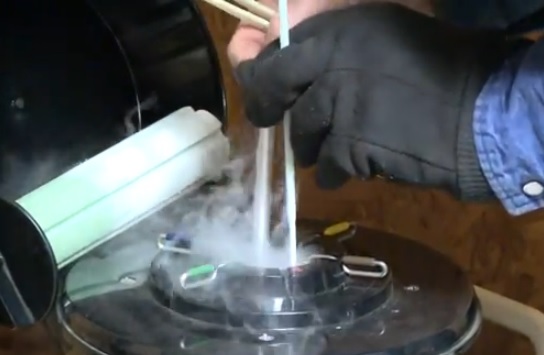
Agricultural News
Top 5 Considerations to Make When Starting an Artificial Insemination Program for Your Cattle Herd
Tue, 11 Apr 2017 12:50:30 CDT
 The following is an article entitled Priorities When Starting an Artificial Insemination Program, authored by Evan Whitley, Ph.D., Center for Advanced Agricultural Systems and Technologies Manager at the Samuel Roberts Noble Foundation.
The following is an article entitled Priorities When Starting an Artificial Insemination Program, authored by Evan Whitley, Ph.D., Center for Advanced Agricultural Systems and Technologies Manager at the Samuel Roberts Noble Foundation.
The Noble Foundation owns and operates approximately 14,000 acres that spans seven ranches and three counties. These properties are used in various ways including conducting applied research and demonstration as well as providing a venue for educational and training events. The process of undertaking these important endeavors starts with implementing an overall management plan that is consistent with commercial beef cattle production. Practically speaking, it is only possible to represent the commercial cattle producer in information collection and dissemination if we operate as a commercial cattle producer. Doing so opens opportunities to share our thought process and decisions as we develop and adapt this overall management outline.
In the January 2017 Ag News and Views article Artificial Insemination Adds Value to Cow Herd, I outlined the value of implementing an artificial insemination (AI) program from a very conceptual perspective. I would now like to expand upon that laid "groundwork" by sharing prioritized considerations, from one cattle producer to another, as we prepare to implement our spring calendar of events, which includes artificially inseminating more than 500 cows. It's important to note that these considerations are only meant to provide a framework for producers to build upon.
Prioritized Considerations
1. Predetermine outcomes prior to implementation based upon listed goals and objectives
I realize setting goals isn't fun, but it is necessary, especially as we determine the value in branching into something new. These goals need to include optimizing soil and forage resources exhibited at the ranch level, minimizing costs of production, and maximizing marketing opportunities.
At the Noble Foundation, we are keenly interested in ensuring a supply of calves for all of our research, demonstration, teaching, herd maintenance/expansion and marketing needs, taking full advantage of opportunities across all segments of beef production. Thus, our breeding program, including AI, must reflect this goal.
2. Determine limitations to implementation
As I mentioned in the previous article, inadequate facilities and inaccessibility to qualified labor are very real obstacles. Keep in mind that an AI program will get you closer to your cattle, but you don't want them too close. Therefore, adequate facilities and access to labor (quality and quantity) are extremely important.
3. Differentiate the AI from the bull-bred calves
Although benefits of a typical commercial AI program include less bull dependency and synchronized heat cycles (assuming timed breeding), utilize this effort as an opportunity to meet additional objectives by selecting the AI sire on different/additional criteria than cleanup bulls.
Here at the Noble Foundation, we select our AI bulls (Angus) for maternal, paternal and carcass traits. We select our cleanup bulls (Charolais) for paternal and carcass traits. Doing so accomplishes three goals: increases access to the maternal genetics that will positively influence our cow herd long-term, utilizes bull purchases to increase the marketability of younger calves, and genetically stamps the calves so we readily know the difference.
4. Don't get hung up on individual pedigrees, but execute a repeatable process
Please don't interpret this to mean that individual data is not important and shouldn't be used during the selection process. However, the viability of an AI program will come down to AI pregnancies and cost of semen. Increasing AI conception is a stand-alone topic; however, minimizing semen cost is a balance between selected traits, accuracy of those traits and popularity of the individual sire. If the popularity of the bull grows over time, so will his semen cost. You need a backup proven selection process to maintain your breeding goals and objectives using another bull. We try to keep our semen costs below $20 per straw. Last year, our average semen cost was approximately $15 per straw.
5. Develop a good relationship with a reputable AI or breeding service representative
This will be especially beneficial during the first year's transition. There are many out there to choose from, but a point to consider is access to a robust database of available sires. Last year, we sorted through almost 300 potential sires to a list of seven and made our pick from a list of four due to unavailability of semen for the other three, which is a good lesson. Just because a sire is listed in the catalog doesn't mean he is a viable choice. Start the selection process early and keep your breeding service representative abreast of your progress so they can keep you informed of important company information.
Our Selection Criteria
Specifically, our selection criteria consisted of an AI sire being in the top one-third of the Angus breed for calving ease (direct and maternal), growth (weaning and yearling) and marbling, and moderate (top 50 percent) on other important traits such as birth weight, milk, mature weight/height and the price indexes. We feel this complements our cleanup bulls, which have been selected for high growth and carcass merit and will ultimately provide us with the greatest number of viable options to either retain or market the resulting calf crops.
Again, this is not an exhaustive list but points to consider based upon experiential knowledge regarding a progressive management practice that could add significant value to a well-managed commercial cow-calf operation, under the right circumstances and for the right reasons. If you need assistance please give us a call.
Source - Samuel Roberts Noble Foundation
WebReadyTM Powered by WireReady® NSI
Top Agricultural News
More Headlines...





